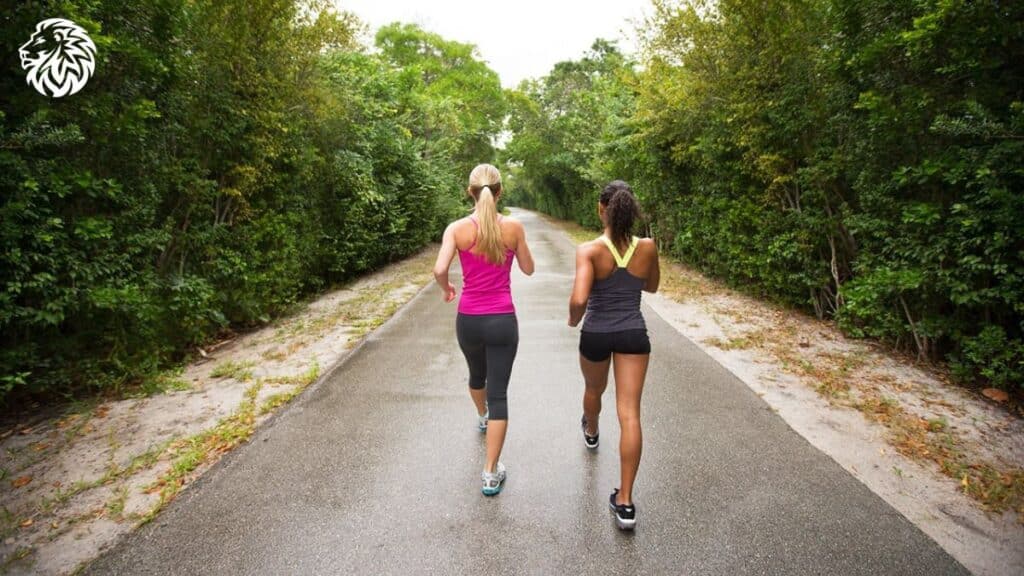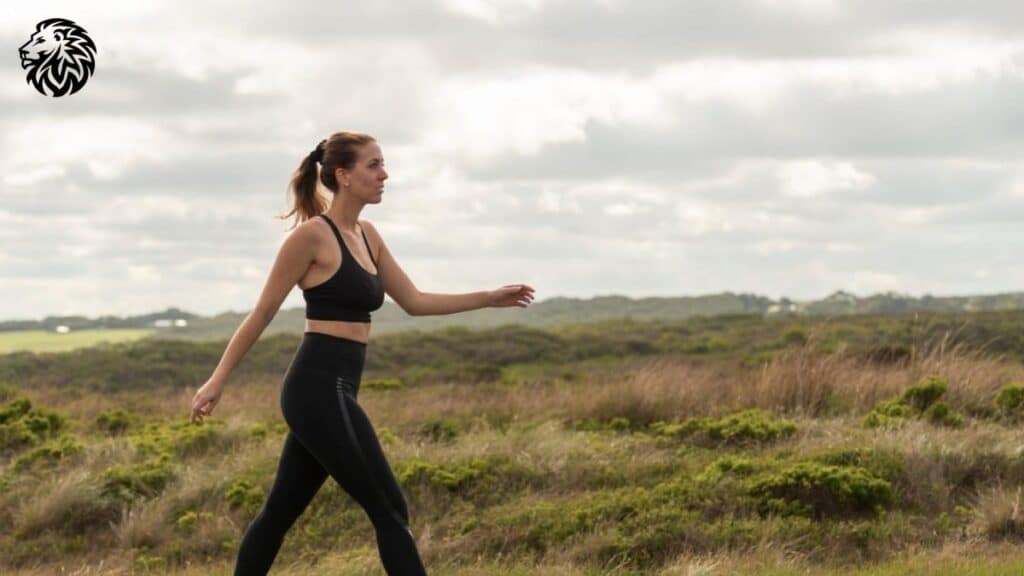Regular exercise is undoubtedly vital for maintaining optimal health and working towards weight loss goals. Yet, the quest for an enjoyable, sustainable workout routine proves challenging for many. Enter walking: a straightforward, accessible, and efficient solution. This article will explore the scientific basis of walking’s effectiveness for weight loss and belly fat reduction, the additional health benefits of this low-impact activity, and offer practical tips to maximize your daily walks. Frequently asked questions about walking and weight loss will also be addressed.
The Science Behind Walking and Weight Loss
Calories Burned While Walking
Factors that influence calorie expenditure
Several factors determine the number of calories you burn while walking. These include:
- Body weight: Heavier individuals tend to burn more calories during a walk because they require more energy to move their body weight.
- Walking speed: Walking at a faster pace increases your heart rate and leads to higher calorie expenditure.
- Distance covered: Walking for longer distances will naturally result in a higher number of calories burned.
- Terrain: Walking uphill or on an uneven surface requires more effort, thus increasing calorie burn.
- Walking technique: Using proper walking form and engaging core muscles can help you burn more calories.
How walking compares to other forms of exercise
While walking is a low-impact exercise, it can still be an effective calorie-burner. For example, a 155-pound person walking at a moderate pace of 3.5 mph can burn approximately 149 calories in 30 minutes[1]. This calorie burn is comparable to activities like water aerobics, yoga, or light gardening. However, more vigorous exercises like running, swimming, or cycling typically burn more calories per minute. Nonetheless, walking remains an excellent option for individuals who prefer a gentler form of exercise or are new to fitness.
Walking’s Impact on Belly Fat
The role of aerobic exercise
As a form of aerobic exercise, walking is particularly adept at combatting visceral fat – the type surrounding your organs and linked to numerous health risks[2]. By raising your heart rate and enhancing your body’s ability to burn fat as fuel, aerobic exercises like walking facilitate fat loss.
The importance of consistency
Consistency is crucial when it comes to losing belly fat through walking. The American Heart Association recommends at least 150 minutes of moderate-intensity aerobic activity or 75 minutes of vigorous-intensity aerobic activity per week for overall cardiovascular health[3]. By consistently meeting or exceeding these recommendations through walking, you increase your chances of reducing belly fat and improving your overall health.

Additional Health Benefits of Walking
Improved Heart Health
Walking offers several heart health benefits. Regular walking can help:
- Reduced blood pressure: Enhanced blood circulation through walking can result in a gradual decrease in blood pressure.
- Reduce cholesterol levels: Walking can increase your levels of high-density lipoprotein (HDL) cholesterol, the “good” cholesterol that helps remove low-density lipoprotein (LDL) cholesterol, the “bad” cholesterol, from your bloodstream[4].
- Fortified heart muscle: By increasing your heart rate, walking strengthens the heart muscle and heightens its efficiency.
- Decrease the risk of cardiovascular diseases: Consistent walking reduces the risk of heart diseases, stroke, and other cardiovascular issues by promoting a healthy lifestyle and improving overall heart health.
Better Mental Well-being
Walking has been shown to have positive effects on mental health. These benefits include:
- Stress relief: The release of endorphins, or “feel-good” hormones, during walking can contribute to lower stress levels[5].
- Mood elevation: Exposure to natural sunlight during outdoor walks helps regulate serotonin production, a neurotransmitter associated with happiness and well-being.
- Sharpened cognitive function: Regular physical activities, including walking, correlate with improved cognitive function, memory retention, and a reduced risk of dementia development[6].
- Alleviation of anxiety and depression symptoms: Walking has been shown to mitigate symptoms of anxiety and depression, rendering it a valuable complementary treatment[7].
Enhanced Muscle Tone and Strength
While walking primarily targets the muscles in your lower body, it can also have a positive impact on your overall muscle tone and strength:
- Strengthening leg muscles: Walking helps build and tone muscles in your calves, thighs, and glutes, leading to better stability and endurance.
- Engaging core muscles: Maintaining proper posture while walking engages your core muscles, which can help improve balance and overall strength.
- Supporting joint health: Regular walking can help strengthen the muscles around your joints, which may help alleviate joint pain and stiffness associated with conditions like arthritis[8].
- Boosting upper body strength: Incorporating arm movements and carrying small weights while walking can help tone and strengthen the muscles in your upper body.

Practical Tips for Walking to Lose Weight and Burn Belly Fat
Setting Realistic Goals
Establishing achievable goals is essential for staying motivated and consistent in your walking routine. Here are some tips to help you set realistic goals:
- Start slow: If you are new to walking, begin with shorter distances or durations and gradually increase as your fitness level improves.
- Create a walking schedule: Plan your walks ahead of time and include them in your daily or weekly routine. This will help make walking a habit.
- Set measurable objectives: Determine specific goals, such as walking a certain distance or number of steps per day. This will make it easier to track your progress and celebrate your achievements.
- Adjust your goals as needed: Reevaluate your goals periodically and make adjustments based on your progress and personal circumstances.
Choosing the Right Walking Shoes
Wearing proper walking shoes is crucial for ensuring comfort, reducing the risk of injury, and maintaining good walking form. Here are some tips for selecting the right shoes:
- Look for support and cushioning: Choose shoes with adequate arch support and cushioning to absorb shock and reduce stress on your joints.
- Prioritize a comfortable fit: Ensure that the shoes fit well and do not cause discomfort or blisters. There should be enough space in the toe box for your toes to move freely, and your heel should be securely held in place.
- Opt for breathable materials: Shoes made from breathable materials will help prevent excessive sweating and keep your feet dry and comfortable.
- Replace worn-out shoes: Walking shoes should be replaced every 300-500 miles or when they show signs of wear, such as uneven tread or diminished cushioning.
Incorporating Interval Training
Interval training, which involves alternating between periods of higher-intensity walking and lower-intensity recovery, can help you burn more calories and improve your overall fitness. To incorporate interval training into your walking routine:
- Warm-up: Begin with a 5-10 minute warm-up walk at a comfortable pace.
- Increase intensity: Walk at a faster pace or uphill for a set duration (e.g., 1-2 minutes), aiming to elevate your heart rate.
- Recover: Slow down to a comfortable pace for a recovery period (e.g., 1-2 minutes) before repeating the cycle.
- Cool down: Conclude your walk with a 5-10 minute cool-down at a slower pace to help your heart rate return to normal.
Tracking Your Progress
Monitoring your progress can help you stay motivated and focused on your goals. Consider using the following methods to track your walking progress:
- Fitness tracker or smartphone app: Use a device or app to count your steps, measure distance, and track other fitness metrics.
- Journal or log: Keep a written record of your daily walks, including distance, duration, and any observations or challenges.
- Visual reminders: Create a visual representation of your progress, such as a calendar or chart, to serve as a constant reminder of your achievements.
- Share your progress: Discuss your walking journey with friends, family, or online communities for additional motivation and support.

Conclusion
Walking is an accessible and effective way to lose weight and burn belly fat. With consistency and proper planning, this low-impact exercise can yield significant health benefits and help you achieve your weight loss goals. By understanding the science behind walking and implementing practical tips, you can transform your daily walks into a powerful tool for improving your overall health and well-being.
Frequently Asked Questions
How long should I walk each day to lose weight?
The American Heart Association recommends at least 150 minutes of moderate-intensity aerobic activity or 75 minutes of vigorous-intensity aerobic activity per week for overall cardiovascular health[9]. To lose weight, you may need to increase these recommendations. Aim for at least 30-60 minutes of walking per day, most days of the week. However, it is essential to listen to your body and adjust the duration and intensity of your walks according to your fitness level and personal goals.
Is walking better than running for weight loss?
Both walking and running can contribute to weight loss, but running generally burns more calories per minute. However, walking may be a more sustainable and enjoyable option for some individuals, particularly those who are new to fitness or prefer a low-impact exercise. Ultimately, the best exercise for weight loss is the one you can maintain consistently over time.
Can I lose weight by walking alone, or do I need to change my diet as well?
Although walking indeed assists in calorie burning and weight loss, coupling it with a nutritious diet amplifies the outcomes. Effectively shedding pounds necessitates a calorie deficit, wherein more calories are expended than consumed. A well-rounded diet abundant in whole foods, fruits, vegetables, lean proteins, and healthy fats paves the way for achieving a calorie deficit, bolstering weight loss aspirations.
How can I make my daily walks more enjoyable and motivating?
To make your daily walks more enjoyable and motivating, consider:
- Walking with a friend, family member, or pet for social interaction and support.
- Listening to music, podcasts, or audiobooks to keep your mind engaged.
- Varying your walking routes and exploring new locations to maintain interest and challenge your body.
- Setting goals and tracking your progress to stay focused and motivated.
- Participating in walking challenges or organized events to add a sense of purpose and accomplishment to your routine.
What is the optimal walking speed for weight loss?
The optimal walking speed for weight loss varies depending on your fitness level and personal goals. As a general guideline, aim for a brisk walking pace that elevates your heart rate to around 60-70% of your maximum heart rate[10]. This pace is typically between 3-4 mph for most individuals. Incorporating interval training, which involves alternating between periods of higher-intensity walking and lower-intensity recovery, can help increase calorie burn and improve overall fitness.
References:
- Harvard Health Publishing. (2021). Calories burned in 30 minutes for people of three different weights. Retrieved from https://www.health.harvard.edu/diet-and-weight-loss/calories-burned-in-30-minutes-of-leisure-and-routine-activities
- Slentz, C.A., Bateman, L.A., Willis, L.H., et al. (2011). Effects of aerobic vs. resistance training on visceral and liver fat stores, liver enzymes, and insulin resistance by HOMA in overweight adults from STRRIDE AT/RT. American Journal of Physiology – Endocrinology and Metabolism, 301(5), E1033-E1039. https://doi.org/10.1152/ajpendo.00291.2011
- American Heart Association. (2021). American Heart Association recommendations for physical activity in adults and kids. Retrieved from https://www.heart.org/en/healthy-living/fitness/fitness-basics/aha-recs-for-physical-activity-in-adults
- American Heart Association. (2018). Walking and cholesterol. Retrieved from https://www.heart.org/en/healthy-living/fitness/walking/walking-and-cholesterol
- Mayo Clinic. (2021). Exercise and stress: Get moving to manage stress. Retrieved from https://www.mayoclinic.org/healthy-lifestyle/stress-management/in-depth/exercise-and-stress/art-20044469
- Hamer, M., & Chida, Y. (2009). Physical activity and risk of neurodegenerative disease: A systematic review of prospective evidence. Psychological Medicine, 39(1), 3-11. https://doi.org/10.1017/S0033291708003681
- Carek, P.J., Laibstain, S.E., & Carek, S.M. (2011). Exercise for the treatment of depression and anxiety. The International Journal of Psychiatry in Medicine, 41(1), 15-28. https://doi.org/10.2190/PM.41.1.c
- Arthritis Foundation. (n.d.). Benefits of walking for people with arthritis. Retrieved from https://www.arthritis.org/health-wellness/healthy-living/physical-activity/walking/benefits-of-walking-for-people
- American Heart Association. (2021). American Heart Association recommendations for physical activity in adults and kids. Retrieved from https://www.heart.org/en/healthy-living/fitness/fitness-basics/aha-recs-for-physical-activity-in-adults
- Mayo Clinic. (2021). Walking: Trim your waistline, improve your health. Retrieved from https://www.mayoclinic.org/healthy-lifestyle/fitness/in-depth/walking/art-20046261







